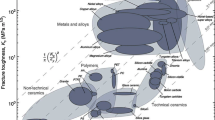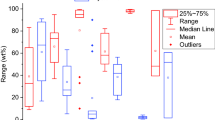The correlation between the volumetric thermal expansion coefficient (VLEC) o(T ) and specific heat C(T) of corundum α-Al2O3 is examined in detail. It is shown that there is a clear correlation o(C) not only at low temperatures (to about 50 K), where it is linear (Grüneisen’s law), but also in a wider temperature range, viz., up to the melting point of corundum. Asignificant deviation from the low-temperature linear behavior of the temperature dependence of the VTEC o(C) occurs when the specific heat reaches the Dulong–Petit classical limit 5.3R. The results of the present work can be used to verify the data from primary calorimetric and dilatometric studies of ceramic and other materials.




Similar content being viewed by others
References
Aluminum Oxide; URL: http://ru.wikipedia.org/wiki/oкcид_aлюmиния.
E. V. Zharikov, K. S. Zaramenskikh, N. A. Popova, P. P. Faikov, et al., “Carbon nanotube reinforced corundum-based composite material,” Steklo Keram., No. 3, 12 – 16 (2011); E. V. Zharikov, K. S. Zaramenskikh, N. A. Popova, P. P. Faikov, et al., “Carbon nanotube reinforced corundum-based composite material,” Glass Ceram., 68(3 – 4), 80 – 84 (2011).
V. V. Sirota, E. S. Gevorkyan, M. G. Kovaleva, and V. V. Ivanisenko, “Structure and properties of nanoporous ceramic Al2O3 obtained by isostatic pressing,” Glass Ceram., No. 10, 24 – 28 (2012); V. V. Sirota, E. S. Gevorkyan, M. G. Kovaleva, and V. V. Ivanisenko, “Structure and properties of nanoporous ceramic Al2O3 obtained by isostatic pressing,” Glass Ceram., 69(9 – 10), 342 – 345 (2012).
N. A. Fedosova, P. P. Faikov, N. A. Popova, et al., “Effect of the nature of carbon nanotubes on the structure and strength of ceramic composites,” Steklo Keram., No. 4, 22 – 26 (2014); N. A. Fedosova, P. P. Faikov, N. A. Popova, et al., “Effect of the nature of carbon nanotubes on the structure and strength of ceramic composites,” Glass Ceram., 71(3 – 4), 128 – 131 (2014).
T. Goto, O. L. Anderson, I. Ohno, and S. Yamamoto, “Elastic constants of corundum up to 1825 K,” J. Geophys. Res. B: Solid Earth, 94(6), 7588 – 7602 (1989).
V. Yu. Bodryakov and A. A. Bykov, “A particularity of the correlation dependence for the volumetric thermal expansion coefficient on its heat capacity,” Aktyal’nye Innovatsionnye Issled.: Nauka i Praktika: Élektron. Nauch. Izd., No. 1 (2014).
B. Yu. Bodryakov, “On the correlation coefficient of the thermal expansion and specific heat of an argon cryocrystal,” Fiz. Tverd. Tela, 56(11), 2279 – 2285 (2014).
V. Yu. Bodryakov, “On the correlation of the temperature dependences of the thermal expansion and specific heat up to the melting point of a refractory metal: molybdenum,” 52(6), 863 – 869 (2014).
G. T. Furukawa, T. B. Douglas, R. E. McCoskey, and D. C. Ginnings, “Thermal properties of Aluminum Oxide from 0° to 1200°,” J. Res. Natl. Bur. Stand., 57(2), 67 – 82 (1956).
K. K. Kelley, Contributions to the Data on Theoretical Metallurgy. XIII. High Temperature Heat Content, Heat Capacity and Entropy Data for the Elements and Inorganic Compounds, US Government printing office, Washington (1960).
L. A. Novitskii and I. G. Kozhevnikov, Handbook of the Thermophysical Properties of Materials at Low Temperatures [in Russian], Mashinostroenie, Moscow (1975).
R. A. Robie, B. S. Hemingway, and J. R. Fisher, “Thermodynamic properties of minerals and related substances at 298.15 K (25°C) and one atmosphere (1.013 Bars) pressure and at higher temperatures,” in: Geological Survey Bull., US Government printing office, Washington (1979), No. 1452.
L. V. Gurvich, I. V. Veits, V. A. Medvedev, et al., Handbook of the Thermodynamic Properties of Individual Substances [in Russian], Nauka, Moscow (1981), Vol. 3.
D. A. Ditmars, S. Ishihara, S. S. Chang, et al., “Enthalpy and heat capacity standard reference material: synthetic sapphire (α-Al2O3) from 10 to 2250 K,” J. Res. Natl. Bur. Stand., 87(2), 159 – 163 (1982).
R. Castanet, “Selected data on the thermodynamic properties of α-alumina,” High Temp. – High Pressures, 16(4), 449 – 457 (1984).
I. S. Grigor’ev and E. Z. Meilikhov (eds.), Handbook of Physical Quantities [in Russian], Énergoatomizdat, Moscow (1991).
D. G. Archer, “Thermodynamic properties of synthetic sapphire (α-Al2O3), standard reference material 720 and the effect of temperature-scale differences on thermodynamic properties,” J. Phys. Chem. Ref. Data, 22(6), 1441 – 1453 (1993).
O. L. Anderson, Equations of State of Solids for Geophysics and Ceramic Sciences [in Russian], Oxford Monographs on Geology and Geophysics (1995), No. 31.
G. K. White and M. L. Minges, “Thermophysical properties of some key solids: An update,” Int. J. Thermophys., 18(5), 1269 – 1327 (1997).
P. G. Conrad, “The stability of Almandine at high pressures and temperatures,” in: Properties of Earth and Planetary Materials at High Pressure and Temperature, Geophysical Monograph (1998), Vol. 101, pp. 393 – 400.
R. Sabbah, An Xu-wu, J. S. Chickos, et al., “Reference materials for calorimetry and differential thermal analysis,” Thermochim. Acta, 331, 93 – 204 (1999).
G. W. C. Kaye and T. H. Laby, General Physics. Specific Heat Capacities; URL: http://www.kayelaby.npl.co.uk/general physics/2_3/2_3_6.html.
M. W. Chase, NIST-JANAF Tables; URL: http://kinetics. nist.gov/janaf/html/Al-101.html.
Property Tables and Charts; URL: http://highered. mcgrawhill.com/sites/dl/free/0073398128/835451/App1.pdf
Yutopian Online: Thermal and Mechanical Properties of Sapphire; URL: http://www.yutopian.com/Yuan/prop/Sapphire.html.
J. B.Wachtman, T. G. Scuderi, and G.W. Cleek, “Linear thermal expansion of aluminum oxide and thorium oxide from 100 to 1100 K,” J. Am. Ceram. Soc., 45(7), 319 – 323 (1962).
A. Schauer, “Thermal expansion of solids and the temperature dependence of lattice vibration frequencies,” Can. J. Phys., 42(10), 1857 – 1864 (1964).
A. N. Amatuni and E. B. Shevchenko, “Linear thermal expansion of single-crystal quartz and aluminum oxide,” Izmerit. Tekh., No. 10, 17 – 20 (1966).
E. Fitzer and S. Weisenburger, “Cooperative measurement of the thermal expansion behavior of different materials up to 1000°C by pushrod dilatometers,” in: Proc. of the 1971 Thermal Expansion Symposium, AIP Publishing (1972), Vol. 3, No. 1, pp. 25 – 35.
V. A. Petukhov, V. Ya. Chekhovskoi, and Kh. S. Bagdasarov, “Single-crystal aluminum oxide – standard substance in dilatometry,” Teplofiz. Vys. Temp., 11(5), 1083 – 1087 (1973).
A. N. Amatuni, T. I. Malyutina, V. Y. Chekhovskoi, and V. A. Petukhov, “Standard samples for dilatometry,” High Temp. – High Press., 8(3), 565 – 570 (1976).
G. K. White and R. B. Roberts, “Thermal expansion of reference materials: tungsten and α-Al2O3 ,” High Temp. – High Press., 15(2), 321 – 328 (1983).
P. Aldebert and J.-P. Traverse, “α-Al2O3: A high-temperature thermal expansion standard,” High Temp. – High Press., 16(2), 127 – 135 (1984).
G. Fiquet, P. Richet, and G. Montagnac, “High-temperature thermal expansion of lime, periclase, corundum and spinel,” Phys. Chem. Minerals, 27(2), 103 – 111 (1999).
T. A. Kompan, A. S. Korenev, A. Ya. Lukin, et al., “Standard measures of thermal expansion made from single-crystalline aluminum oxide for a wide temperature range,” Izmerit. Tekh., No. 8, 38 – 42 (1999).
R. R. Reeber and K.Wang, “Lattice parameters and thermal expansion of important semiconductors and their substrates,” MRS Proc., 622(T6.35), 1 – 6 (2000).
G. W. C. Kaye and T. H. Laby, General Physics. Thermal Expansion; URL: http://www.kayelaby.npl.co.uk/general_physics /2_3/2_3_5.hhtml.
Author information
Authors and Affiliations
Corresponding author
Additional information
Translated from Steklo i Keramika, No. 2, pp. 30 – 33, February, 2015.
Rights and permissions
About this article
Cite this article
Bodryakov, V.Y., Bykov, A.A. Correlation Characteristics of the Volumetric Thermal Expansion Coefficient and Specific Heat of Corundum. Glass Ceram 72, 67–70 (2015). https://doi.org/10.1007/s10717-015-9726-2
Published:
Issue Date:
DOI: https://doi.org/10.1007/s10717-015-9726-2




